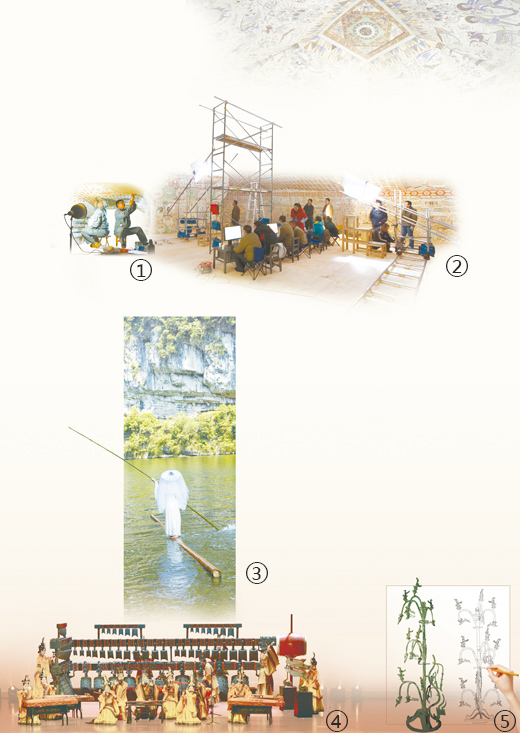Protectors of China’s traditional heritage safeguard, promote nation’s cherished cultural wonders for posterity
June 11 marks this year’s Cultural and Natural Heritage Day in China, which falls on the second Saturday of June every year. To demonstrate China’s remarkable achievements in its cultural heritage protection, People’s Daily would like to introduce you to several conservators of cultural heritage across the country.

①② Team members from the Dunhuang Academy repair murals and collect digital data at a cave inside the Mogao Grottoes in Dunhuang city, northwest China’s Gansu Province. (Photo courtesy of Dunhuang Academy)
③ Yang Liu, an inheritor of single bamboo drifting – a national intangible cultural heritage originating from southwest China’s Guizhou Province – gives a performance of single bamboo drifting. (Photo courtesy of Yang Liu)
④ Artists from the Hubei Provincial Museum Chime Bell Orchestra give a performance. (Photo/Ma Yeping)
⑤ Photo shows a bronze sacred tree from the Sanxingdui Ruins site in southwest China’s Sichuan Province and an archaeological illustration of the scared tree. (Photo courtesy of Sanxingdui Museum)
Su Bomin, dean of the Dunhuang Academy, has been working for three decades at the Mogao Grottoes, a UNESCO World Heritage site located in Dunhuang city, northwest China’s Gansu Province.
When Su began to work at the Mogao Grottoes, he focused on research related to color changes to the murals painted inside the caves.
Su likens the preservation of murals to that of doctors treating patients. To better protect the Mogao murals, he said that researchers should first find out why problems such as the blistering of the murals occurs.
Su introduced that in the past the restoration of caves and murals was not systematic and many problems were resolved based only on senior experts’ experience alone due to a lack of understanding about the reasons behind these problems. After the restoration of Cave No. 85, Su and his colleagues figured out the steps and methods needed to protect a cave. Since then, the preservation of cultural relics inside the Mogao Grottoes has become systematic and science-based.
Su said technology is now playing an increasingly important role in the preservation and research of cultural relics. Over the course of the past 30 years, the Mogao Grottoes have witnessed great improvements, including the site’s preservation philosophy, management level, application of science and technology, and cultural transmission capabilities, all thanks to generations of protection efforts.
Su pointed out that his team has more than 300 members who can research the murals without touching them and ensure preventative conservation measures with the support of multispectral analysis and other technologies. Besides, information on over 260 caves has now been collected digitally. Su is also committed to letting more people better appreciate the lasting charm of the Mogao Grottoes.
Yang Liu is an inheritor of single bamboo drifting – a national intangible cultural heritage originating from southwest China’s Guizhou Province. Yang has practiced single bamboo drifting for 18 years.
Single bamboo drifting is a traditional artform that emerged in the Chishui River Basin of northern Guizhou, where local people in the past would often attempt to cross the river. Nowadays, it has evolved into a popular folk sport.
Yang learned the skills of bamboo drifting from her grandmother at the age of seven. She needed to stand upright on a bamboo pole that was 9 meters in length and 15 centimeters in diameter while drifting on water and enduring all the physical pain that came with mastering the different motions.
Yang later incorporated dancing skills, along with hanfu, a type of traditional clothing of the Han ethnic group, and elements of Chinese opera into her bamboo drifting performances.
Yang has shared videos of herself performing single bamboo drifting online, winning high praise from viewers from home and abroad.
Noting that she will continue to develop new ways to create single bamboo drifting performances, Yang aspires to familiarize people with the artform not just in the country but the rest of the world.
Ma Yeping is the deputy head of the Hubei Provincial Museum Chime Bell Orchestra in central China’s Hubei Province.
In 1978, a set of chime bells, a kind of ancient Chinese musical instrument that remained buried underground for more than 2,400 years, was unearthed in Hubei from the Tomb of Marquis Yi, a ruler of the ancient Zeng State. To test the musical notes of the original Chime Bells of the Marquis Yi of Zeng, which are rated as grade-one national cultural relics, musicians performed several songs and pieces of music with the chime bells.
In 1984, the Hubei Provincial Museum established an orchestra with the help of the Hubei Academy of Arts (now the Wuhan Conservatory of Music).
Ma, who graduated from the Wuhan Conservatory of Music, managed to master the skills of playing chime bells. Ma was one of the six performers who played chime bells in a ceremony to mark the establishment of the Hong Kong Special Administrative Region in 1997.
Since the 1990s, chime bell performances have been staged in many famous concert halls across the world. The number of people who have already heard the sound of chime bells has reached over 600 million person-times.
Luo Zeyun is an archaeological illustrator with the Sichuan Provincial Cultural Relics and Archaeology Research Institute in southwest China’s Sichuan Province. Luo has drawn more than 50,000 archaeological illustrations over the past 30 years.
Luo began to engage in archaeological illustration, a form of technical illustration that records material derived from an archaeological context graphically, in 1992 for the publication of an archaeological report about the No.1 and No. 2 sacrificial pits at the Sanxingdui Ruins site discovered in Sichuan.
According to Luo, archaeological illustration is a demanding job. Luo spent nearly one year finishing an archaeological illustration of a bronze sacred tree from the Sanxingdui Ruins site. Luo hopes that an increasingly larger number of young people will come to know more about and love the job that he does.
Photos
Related Stories
- China tops world in number of world natural heritage sites
- Xi Focus-Closeup: Protect historical heritage like cherishing life
- China steps up weather protection for cultural heritage sites, artifacts
- Beijing enhances intangible cultural heritage preservation
- China to improve management of revolutionary heritage assets, resources
- China discovers 635 cave temples, cliff statues
- NW China's Suoyang City Ruins home to intact ancient military defense, irrigation systems
- Artisans showcase handmade products at Egypt's largest heritage expo
- Exhibition featuring Bronze Age civilizations held in Chengdu
- Eye-catching scenery captured in World heritage site Hongcun village
Copyright © 2022 People's Daily Online. All Rights Reserved.









